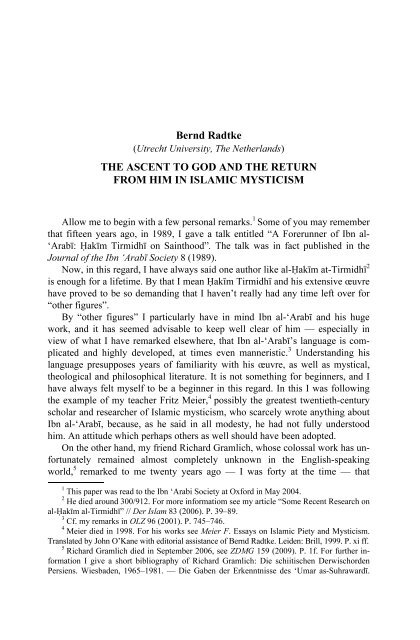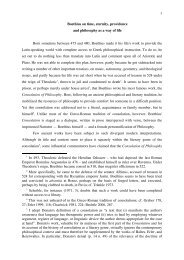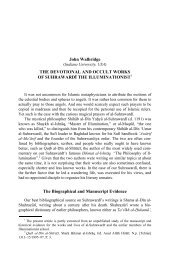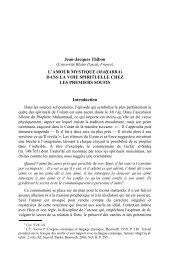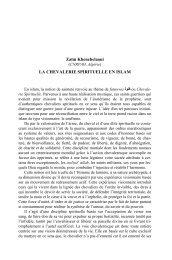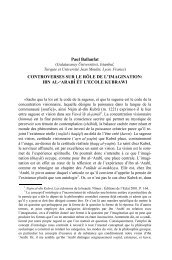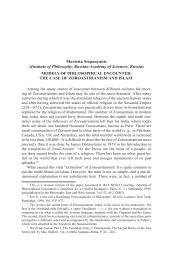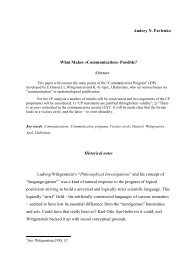Bernd Radtke THE ASCENT TO GOD AND THE RETURN FROM ...
Bernd Radtke THE ASCENT TO GOD AND THE RETURN FROM ...
Bernd Radtke THE ASCENT TO GOD AND THE RETURN FROM ...
Create successful ePaper yourself
Turn your PDF publications into a flip-book with our unique Google optimized e-Paper software.
98Sufism and ‘Irfan: Ibn al-‘Arabi and His School * <strong>Bernd</strong> <strong>Radtke</strong><strong>Bernd</strong> <strong>Radtke</strong>(Utrecht University, The Netherlands)<strong>THE</strong> <strong>ASCENT</strong> <strong>TO</strong> <strong>GOD</strong> <strong>AND</strong> <strong>THE</strong> <strong>RETURN</strong><strong>FROM</strong> HIM IN ISLAMIC MYSTICISMAllow me to begin with a few personal remarks. 1 Some of you may rememberthat fifteen years ago, in 1989, I gave a talk entitled “A Forerunner of Ibn al-‘Arabī: Ḥakīm Tirmidhī on Sainthood”. The talk was in fact published in theJournal of the Ibn ‘Arabī Society 8 (1989).Now, in this regard, I have always said one author like al-Ḥakīm at-Tirmidhī 2is enough for a lifetime. By that I mean Ḥakīm Tirmidhī and his extensive œuvrehave proved to be so demanding that I haven’t really had any time left over for“other figures”.By “other figures” I particularly have in mind Ibn al-‘Arabī and his hugework, and it has seemed advisable to keep well clear of him — especially inview of what I have remarked elsewhere, that Ibn al-‘Arabī’s language is complicatedand highly developed, at times even manneristic. 3 Understanding hislanguage presupposes years of familiarity with his œuvre, as well as mystical,theological and philosophical literature. It is not something for beginners, and Ihave always felt myself to be a beginner in this regard. In this I was followingthe example of my teacher Fritz Meier, 4 possibly the greatest twentieth-centuryscholar and researcher of Islamic mysticism, who scarcely wrote anything aboutIbn al-‘Arabī, because, as he said in all modesty, he had not fully understoodhim. An attitude which perhaps others as well should have been adopted.On the other hand, my friend Richard Gramlich, whose colossal work has unfortunatelyremained almost completely unknown in the English-speakingworld, 5 remarked to me twenty years ago — I was forty at the time — that1 This paper was read to the Ibn ‘Arabi Society at Oxford in May 2004.2 He died around 300/912. For more informatiom see my article “Some Recent Research onal-Ḥakīm al-Tirmidhī” // Der Islam 83 (2006). P. 39–89.3 Cf. my remarks in OLZ 96 (2001). P. 745–746.4 Meier died in 1998. For his works see Meier F. Essays on Islamic Piety and Mysticism.Translated by John O’Kane with editorial assistance of <strong>Bernd</strong> <strong>Radtke</strong>. Leiden: Brill, 1999. P. xi ff.5 Richard Gramlich died in September 2006, see ZDMG 159 (2009). P. 1f. For further informationI give a short bibliography of Richard Gramlich: Die schiitischen DerwischordenPersiens. Wiesbaden, 1965–1981. — Die Gaben der Erkenntnisse des ‘Umar as-Suhrawardī.
The Ascent to God and the Return from Him in Islamic Mysticism 99I should make Ibn al-‘Arabī my life’s work. After all, it must be possible to getat what “the fellow” really means. I did not follow his advice. It has sometimesseemed to me a mistake.In any case, allāh bidabbir, as one says in Arabic. Two years ago a frienddrew my attention to a German translation of Ibn al-‘Arabī’s Risālat al-anwār.I took a look at it and found it rather strange, in fact scarcely understandable. 6I realized it was completely impossible once I compared it against the Arabicoriginal. I then found out that the German translation was based on an Englishtranslation by Rabia Terri Harris, 7 and I also found that a Spanish translationfrom 1931 by Miguel Asín Palacios also existed 8 — and likewise that MichelChodkiewicz offered a partial translation of the text in the final chapter of hisbook Le sceau des saints. 9 A quick look in the 1948 Hayderabad edition of theRasā’il Ibn al-‘Arabī convinced me that I ought to undertake to produce a criticaltext edition with translation and commentary. With the help of friends and colleaguesI was able to obtain copies of a number of manuscripts and so it becamepossible to produce a critical edition. The edition, with German and Englishtranslations, as well as with a commentary, was published in 2005. 10Now, finally, let us turn to the content of the Risālat al-anwār — Epistle onthe Light of Secrets Which are Conferred on a Person During Spiritual Retreat —which is the best form of the title. Other titles have been transmitted as well. 11Wiesbaden, 1978. — Muḥammad al-Ghazzālī’s Lehre von den Stufen der Gottesliebe. Wiesbaden,1984. — Das Sendschreiben al-Qushayrīs. Wiesbaden, 1989. — Schlaglichter über dasSufitum. Wiesbaden, 1990. — Alte Vorbilder des Sufitums. Erster Teil: Scheiche des Westens.Wiesbaden, 1995. The work deals with Muḥammad b. Wāsi‘; Thābit al-Bunānī; Farqad as-Sabakhī; Mālik b. Dīnār; ‘Aṭā’ as-Salīmī; Ibrāhīm b. Adham; Dāwūd aṭ-Ṭā’ī; Abū Turāb an-Nakhshābī; ‘Amr b. ‘Uthmān al-Makkī; Abu l-Ḥusayn an-Nūrī; Ruwaym b. Aḥmad; AbūMuḥammad al-Jurayrī; Abū Bakr ash-Shiblī. — Zweiter Teil: Scheiche des Ostens. Wiesbaden,1996. This part deals with Shaqīq al-Balkhī; Ḥātim al-Aṣamm; Aḥmad b. Khiḍrūya; Abū Ḥafṣal-Ḥaddād; Ḥamdūn al-Qaṣṣār; Abū ‘Uthmān al-Ḥīrī; Abu l-Ḥusayn al-Warrāq; Muḥammad b.al-Faḍl al-Balkhī; Abū Bakr al-Wāsiṭī; Abu l-‘Abbās as-Sayyār. — Ahmad Ghazzali. Gedankenüber die Liebe. Wiesbaden, 1976. — Fakhr ad-dīn ar-Rāzīs Kommentar zu Sure 18, 9–12 //Asiatische Studien XXXIII (1979). P. 99–152. — Muḥammad al-Ġazzālīs kleine islamischeFundamentaldogmatik // Saeculum XXXI (1980). P. 380–398. — Der Urvertrag in der Koranauslegung(zu Sure 7, 172–173) // Der Islam 60 (1983). P. 205–230. — Abū Sulaymān ad-Dārānī // Oriens 33 (1992). P. 22–85. — Die Lebensweise der Könige. Adab al-mulūk. EinHandbuch zur islamischen Mystik. Stuttgart 1993. — Die Wunder der Freunde Gottes. Wiesbaden,1987.6 NkG. Introduction. P. X f.7 <strong>Radtke</strong> B. Neue kritische Gänge. Zu Stand und Aufgaben der Sufikforschung. — NewCritical Essays. On the Present State and Future Tasks of the Study of Sufism. Utrecht, 2005[Henceforth: NkG]. P. 30f.8 NkG. P. 32.9 NkG. P. 31f.10 NkG.11 NkG. P. 27.
100Sufism and ‘Irfan: Ibn al-‘Arabi and His School * <strong>Bernd</strong> <strong>Radtke</strong>The Risāla combines two subjects: 1) the proper conditions for spiritual retreat(khalwa) and 2) what one experiences during it, namely the subject ofmi‘rāj or the heavenly journey. There are parallels for both subjects in Ibn al-‘Arabī’s other works. Chapters 78–81 of the Futūḥāt deal with retreat, whereasChapters 167 and 367 of the Futūḥāt, as well as the Risālat al-isrā’ ilā maqāmal-asrā, deal with the mi‘rāj. A description of all four texts on the mi‘rāj is foundin the anthology The Meccan Illuminations. 12Our text, the Risālat al-anwār, is quite different from the other three, in particularbecause of its short size and omission of the first person narrator.This work belongs to the genre “heavenly journey of the soul or the spirit” inIslam, the history of which still remains to be written. In the meantime we maymention the article of the EI, s.v. mi‘rādj and of the EQ, s.v. Ascension; theworks of scholars like Tor Andrae, Fritz Meier and Josef van Ess, and the collectivevolume edited by Amir-Moezzi, Le voyage initiatique en terre d’islam. 13Ibn al-‘Arabī opens his Risāla with an exposition that explains to the addresseewhat he intends to deal with:“Here is my answer to your questions: How the journey to God is constituted;how one reaches His plane of being, how one through Him returnsfrom Him to the created world again, yet without separating from Him.” 14He goes on to clarify this further:“First, I shall explain how the journey to God is constituted. Then, howone gets to Him, stands before Him, and takes one’s place on the carpet ofseeing God. Further, what God shall say to you. Then, how you return fromHim to the plane of His deeds. This returning happens through and to Him —or how you get annihilated in God; and that is a station which lies before thereturn.” 15Thus Ibn al-‘Arabī wants to describe four things: 1) the journey to God,2) beholding God, 3) the return from God, 4) complete annihilation in God,without returning to the world and one’s fellow-men.He speaks now about helpful and hindering factors for advancing on the mysticpath. Then about the different stages of men’s being (mawāṭin). This journeyto God is arduous, and one should have no illusions about its difficulties.There follows a lengthy discussion about the appropriate place and point intime for beholding God and annihilation. 1612 NkG. P. 28.13 Amir-Moezzi M.A. (ed.). Le voyage initiatique en terre d’Islam, Louvain–Paris: Peeters,1996. More literature on mi‘rāj can be found in NkG. P. 28.14 RA. § 3. P. 45f. I have divided the text of the Risālat al-anwār — quoted as RA — into73 chapters. I give the number of the chapter and the page number in NkG.15 RA. § 5. P. 49f.16 RA. P. § 11–14. P. 62–74.
The Ascent to God and the Return from Him in Islamic Mysticism 101The spiritual retreat is dealt with: finally the necessary preparation. Thismeans, to begin with, withdrawing from people. 17 Likewise, acquiring the religiousknowledge necessary to fulfill the legal prescriptions: praying, fasting, etc.A further step consists of ascetic practices. The highest of these is absolute trustin God (tawakkul). 18 As a result, miracles can be granted to the mystic: shorteningof distances, walking on water, etc. 19A further pre-condition for beginning spiritual retreat: controling one’s fantasy.20 If one cannot accomplish this alone, one must find a shaykh. 21 Generallyspeaking, one must train the soul and restructure it (riyāḍat al-nafs). 22Retreat means abandoning all contacts with one’s fellow-men. Whoever cannotor does not wish to do so is only seeking worldliness. 23Next, the dhikr-formula employed during retreat is discussed 24 and advice isgiven concerning nourishment while in retreat. 25 Likewise, one must learn todistinguish between different random thoughts (wāridāt) which may occur duringretreat. They may be of spiritual-angelic or of hellish-satanic origin. 26Similarly, false “gods” may reveal themselves to a person’s consciousness. Ingeneral, everything which appears in the way of random thoughts and visionsduring retreat is a test from God which one must undergo. 27Among such tests there are unveilings (kashf, mukāshafa) which a person experiencesin meditation. This can occur throughout the hierarchical stages ofbeing. The cover of the perceptible world is removed for the meditating person.His inner vision penetrates the walls of houses and sees what people are doinginside. However, this must not seduce him into divulging these secrets to others.28 At this point Ibn al-‘Arabī injects a short remark about the various kinds ofunveiling, which I will not enter into here. 29 After this he returns once more tonourishment during retreat 30 and then speaks in general terms about ascensionfrom the world of imagination (‘ālam al-khayāl) to the world of pure ideas andto God. 3117 RA. § 15. P. 75.18 RA. § 16. P. 77.19 RA. § 17. P. 79.20 RA. § 18. P. 81.21 RA. § 18. P. 81.22 RA. § 19. P. 83.23 RA. § 20. P. 85.24 RA. § 22. P. 88.25 RA. § 23. P. 90.26 RA. § 24. P. 92.27 RA. § 26. P. 96.28 RA. § 27–28. P. 98–100.29 RA. § 29. P. 102–108.30 RA. § 30. P. 108.31 RA. § 31. P. 110.
102Sufism and ‘Irfan: Ibn al-‘Arabi and His School * <strong>Bernd</strong> <strong>Radtke</strong>Ascension through the perceptible world advances from the mineral realm tothe realm of plants and on to the realm of animals. The occult characteristics(khawāṣṣ) of each realm are unveiled for the meditating person. 32There then follows an interim observation:“You see the modes of remembrance of God which you use. Now you seethat the other worlds use the same remembrance of God as you do, and so theunveilings (which have been shown to you) remain merely as imaginationand are not real. Your (own) state becomes manisfest to you in these things.However, when you see their different mode of remembrance of God in theother worlds, then you experience real unveilings. This ascension is a dissolution,but at the same time a contraction.” 33The last sentence means, among other things, that the meditating person hasleft behind the realm of natural elements and now begins his ascension throughthe planetary spheres. In another work where Ibn al-‘Arabī speaks of his ownheavenly journey, he describes stripping away the elements as follows:“When God wished to travel by night with me, he removed me from myplace and conducted me upward on the Burāq of my capacity. I did not seethat any earth accompanied me… When I lost the element water, I lost a partof me. When I came to the element air… I lost it. When I came to the elementfire… I pushed forward to the first heaven, and of my corporal naturenothing that I could find support in remained with me.” 34The ascension through the planetary spheres — in the classical order: theMoon, Mercury, Venus, the Sun, Mars, Jupiter and Saturn — is described in thefollowing sections. 35 In each case Ibn al-‘Arabī indicates the particular effect thateach planetary sphere exerts on earthly events and which prophet plays the leadingrole in the sphere concerned.After the sphere of Saturn, the ‘illiyyūn or the loftiest heights are dealt with.This sphere is the sphere of the lotus-tree (sidrat al-muntahā). Here the mysticlooks at Paradise and Hell in their particulars and sees spirits which have becomeannihilated in beholding God. Here he also sees himself and his destiny. Then heis granted sight of the Celestial Throne and Universal Intelligence. 36What Ibn al-‘Arabī experiences next, he describes as follows:“If you do not stop here, the Mover of the Pen will disclose Himself toyou. Then if you do not stop here, you will be eradicated, made to vanish, beextinguished, annihilated. When the effects of the divine name ‘the Eradica-32 RA. § 32–34. P. 113–118.33 RA. § 35. P. 118.34 NkG. P. 120, in the commentary on RA. § 35.35 RA. § 36–45. P. 122–141.36 RA. § 45–48. P. 141–147.
The Ascent to God and the Return from Him in Islamic Mysticism 103tor’ and the companions of this name come to an end within you, then youwill receive sure footing, will be brought before the divine presence, will bemade firm, will be united with God, then be made essential. You will bedressed in robes of honor, which you need variously, for they will be of differentkinds. After that, you will be returned to your origin. Everything youhave seen you will now perceive in a different manner. Either you will be returnedto the narrow world of earthly perception or you will remain whereyou were transferred into the state of absence.” 37The effect of the Divine name “Eradicator” is to wipe out the remaining humancharacteristics so that the mystic reaches the state of fanā’, annihilation. Inthe wake of this there follows “permanence” in God — and now the return to the“world” can take place. For this reason Michel Chodkiewicz in his commentaryspeaks of a double échelle, a double ladder, which the mystic must negotiate: hemust ascend to God but then descend into the world again and be active in thelatter while still remaining in God. 38This is alluded to in the following:“As long as the path strider lingers at the goal of the path, he is one ‘whostands at rest’, if he does not return (to the world, to normal consciousness)…Others are sent back (to the world), and they are more perfect than thosewho stand at rest and who were annihilated, but both occupy the same station.”39In another section Ibn al-‘Arabī says:“There are other people whom God takes unto Himself when He descendsover them, and does not send back into the world, but keeps them completelywith Himself. This recurs quite often. The perfect prophetic, apostolic inheritanceconsists in being sent back into the world.” 40The rest of the Risāla describes the effect of “being sent back” and chieflythe relationship of such people to the prophets. I will not enter into that subjecthere. Nor do I wish to enter into further questions concerning spiritual retreat.For those interested in further information on this topic I recommend the articleTwo Sufi Treatises of Aḥmad Ibn Idrīs, which contains a translation ofa small 19th-century treatise on retreat with references to parallel works on thesubject. 4137 RA. § 50. P. 151.38 Chodkiewicz M. Le sceau des saints: prophétie et sainteté dans la doctrine d’Ibn ‘Arabi.Paris: Gallimard, 1986. P. 181 ff.39 RA. § 53. P. 158.40 NkG. P. 161, commentary on RA. § 54.41 <strong>Radtke</strong> B., S. O’Fahey, and J. O’Kane. Two Sufi Treatises of Aḥmad Ibn Idrıs // Oriens35 (1996). P. 143–178.
104Sufism and ‘Irfan: Ibn al-‘Arabi and His School * <strong>Bernd</strong> <strong>Radtke</strong>The basis for Ibn al-‘Arabī’s account of the ascent to God is the ḥadīth aboutthe Prophet’s heavenly ascension which first appears in the 3rd/9th century in thecanonical ḥadīth collections, and then becomes ever more embellished in laterliterature. One can read more about this in the above-mentioned collective volumeLe voyage initiatique en terre d’islam. 42 The ḥadīth in question tells howthe Prophet was escorted by Gabriel through the seven heavens. In each heaventhe corresponding prophet greets him. The same prophets are mentioned by Ibnal-‘Arabī. The heavenly journey in the ḥadīth ends for the time being at the lotus-treeof the extremity.Thus, Ibn al-‘Arabī, in addition to his exposition, prefaces the contents of theḥadīth with a treatment of spiritual retreat and before the actual heavenly journeypresents a passage through the realm of the elements. The end of the Risālaforms what one could call a prophetology and a theory of saints. I may note inclosing that Ibn al-‘Arabī’s complex ontology plays scarcely any role in theRisāla.Besides some personal additions, Ibn al-‘Arabī’s account of the mi‘rāj containsone important divergence from the ḥadīth: he equates the heavens with theplanetary spheres. This was only possible after ancient cosmology, the Ptolemaicworldview, had become assimilated into the Islamic intellectual tradition. 43The subject of “annihilation and return”, one may note, once again takes upthe old motif of fanā’ and baqā’, annihilation and permanence in God, which hadalso been discussed in Sufi literature since the 3rd/9th century. 44Here I would like to consider two Islamic predecessors of Ibn al-‘Arabī, bothof whom lived in the 3rd/9th century, i.e. around 300 years before him. One isthe famous Abū Yazīd al-Basṭāmī/al-Bisṭāmī who died 874. 45 The other, the previouslymentioned al-Ḥakīm at-Tirmidhī who died around 910. Both these mysticswere eastern Iranians.The first, Abū Yazīd, is famous precisely for his heavenly journeys. What weknow about this, however, does not come from himself but was recorded at alater date on the basis of oral tradition within his family. The earliest accountsoriginate in the period around 100 years after his death, i.e. from the second halfof the 4th/10th century. 46I do not wish to enter into details but it is worth pointing out that the cosmiclocations through which Abū Yazīd travels are entirely different from those ofIbn al-‘Arabī. Indeed, he travels through the heavens and the divine veils but notthrough the elements and the planetary spheres. All this has to do with the developmentof cosmological ideas in Islam, as already stated. Further information42 Cf. also Nünlist T. Himmelfahrt und Heiligkeit im Islam. Bern, 2002, especially chapt. I.43 Cf. my Weltgeschichte und Weltbeschreibung, Beirut–Stuttgart, 1993. P. 196 and passim.44 See Gramlich. Derwischorden. Vol. 2. P. 334.45 See EI, s.v. Abū Yazīd.46 Böwering G. Besṭāmī, Bāyazīd // Encyclopedia Iranica (www.iranica.com).
The Ascent to God and the Return from Him in Islamic Mysticism 105about Abū Yazīd al-Basṭāmī can be found in Pierre Lory’s contribution “Lemi‘rāğ d’Abū Yazīd Basṭāmī” in the collective volume Le voyage initiatique enterre d’islam. 47More interesting, at least with regard to Ibn al-‘Arabī, is Ḥakīm Tirmidhī. Heportrays the mystic’s ascent through the cosmos — through a cosmos whosestructure is determined by the concepts of the so-called Islamic cosmology. HereI can only recommend that one consult my immortal book Weltgeschichte undWeltbeschreibung im mittelalterlichen Islam. 48 The first stage which the mysticreaches in his ascent to God is the lowest heaven (samā’ ad-dunyā) — in Ibn al-‘Arabī identified with the sphere of the Moon. From there he ascends — furtherdetails are not given — to the seventh heaven, above which extends “the loftiestheights” (‘illiyyūn) — Ibn al-‘Arabī identifies these with the sphere of the sidratal-muntahā — all the way upward to God’s Throne. The latter is the boundarybetween the created and the uncreated — for above this extend the light-realmsof God’s qualities, the divine veils, which the mystic travels through and understands.In his Sīrat al-awliyā’ Tirmidhī describes the mystic’s ascent as follows:“When he proves true to God in fulfilling the condition and does not seekto undertake works [while] in the place of divine closeness, then he is transportedfrom that place to the realm of tyrannical might in order to be madeupright there. And God compels his carnal soul and subdues it through thepower of tyrannical might so that it becomes submissive and humble. ThenHe transports him from the realm of tyrannical might to the realm of dominionso that he is refined. Now those dispositions which are in the carnal soulmelt away, and they were the foundations of the lusts which had become thecarnal soul’s fixed nature. Then God transports him from there to the realmof loftiness so that he may be disciplined. And from there He transports himto the realm of friendliness so that he may be purified, and then to the realmof majesty so that he may be cleansed, and then to the realm of splendor to berendered sweet-smelling, and then to the realm of joy to be broadened, andthen to the realm of awesomeness to be educated, and then to the realm ofmercy to be refreshed and strengthened and promoted, and then to the realmof divine Singleness to be nourished.And it is divine grace which nourishes him and God’s gentleness whichgathers him and protects him, and God’s love which brings him into divineproximity. And God’s longing brings him close. Then He makes him drawnear. Then He brings him close. And the divine will conveys him to God, andthe Mighty and the Magnanimous One receives him and so He makes himdraw near. Then He brings him close. Then He makes him draw near. ThenHe brings him close. Then He neglects him. Then He conveys him to Him-47 Amir-Moezzi M.A. (ed.). Le voyage initiatique.48 See P. 165.
106Sufism and ‘Irfan: Ibn al-‘Arabi and His School * <strong>Bernd</strong> <strong>Radtke</strong>self. Then He speaks with him intimately. Then He loosens His hold on him.Then He tightens His hold on him. Wherever he goes now, he is in God’sgrasp and one of God’s trustworthy agents. Once he has reached this place,descriptions cease, and words and expressions cease. This is the limit ofhearts and intellects.” 49I think that Ḥakīm Tirmidhī’s text causes one to recall that of Ibn al-‘Arabī.Tirmidhī, however, does not yet distinguish between those “who stand still” andthose who “are sent back”. But in his work “the one sent back” acts as God’sagent in the world as well.There is one further question to be posed: Who actually makes this journey?Of course, I have already said: a person engaged in meditation, the mystic — butwhich part of the meditating person? A peculiarity of the Prophet Muḥammad’sheavenly journey is the assertion that he made the journey in his own body. Thisis a distinguishing feature of being a prophet and is out of the question for themystic.Unfortunately, Ibn al-‘Arabī is not clear about this point, at least not in theRisālat al-anwār. However, one may conclude that the part of a human beingwhich undertakes the journey is the “spirit-being” (rūḥāniyya), 50 i.e. a form ofspirit, for Ibn al-‘Arabī in a passage right at the beginning of the Risāla says thatthe success of the journey to God depends on the strength of the rūḥāniyya. Inanother passage, he says that the Prophet’s heavenly journey takes place bymeans of the primordial light, while the mystic’s heavenly journey occursthrough the light that flows forth from that light. 51 But it is never explained justwhat that light actually is. It is also maintained that the rūḥāniyya of the mysticreceives everything through the rūḥāniyya of the Prophet.In this respect, Ḥakīm Tirmidhī leaves matters even less clear. He does saythat in a dream the spirit — or the soul — ascends to God’s Throne and therereceives dream images. 52 But which part of a human being participates in theascension, during a mystical experience in a waking state, is not made clear. Allthat is said is that “man, the path strider, etc.” travels to God. Thus it is unclearwhether in this case a “real” journey is meant, i.e. an actual traveling through thecosmos, or merely one in the imagination 53 — questions which for the time beingcannot be answered.The idea of a heavenly journey is not an exclusively Islamic phenomenon. Inparticular it appears in the context of Gnosticism. There one also deals, for instance,with traveling through the planetary spheres — though within a very dif-49 <strong>Radtke</strong> B. and J. O’Kane. The Concept of Sainthood in Early Islamic Mysticism. Richmond,1996. P. 194f.50 RA. § 6. P. 51.51 RA. § 59. P. 172f.52 <strong>Radtke</strong>. Concept. P. 136f.53 <strong>Radtke</strong>. Concept. P. 50f.
The Ascent to God and the Return from Him in Islamic Mysticism 107ferent cosmological context. Likewise, Judaism and early Christianity are familiarwith heavenly journeys. 54 In the case of Christianity we may mention TheBook of the Holy Hierotheos which was composed in the 5th century. It displaysforms of dependence on the writings of Pseudo-Dionysius the Areopagite. 55How all this affected Islamic mysticism and spirituality has not yet been seriouslystudied — and our Risālat al-anwār can be taken as a building block inany project to answer such a question.But before coming to grips with mysticism, here as well the good Lord hasimposed the task of sound philology. And philology means that a person endeavorsto understand what a text says — and not what he might like it to say. WhatIbn al-‘Arabī describes in the following way in the Risālat al-anwār may thenbecome unveiled for a receptive seeker:“If you don’t stop at this point, the levels of the speculative sciences andcorrect ideas will be unveiled for you, as well as the forms of error which canafflict the understanding. And likewise the difference between knowledgeand fantasy.”Let us hope that many a student of Ibn al-‘Arabī is granted this experience onhis heavenly journey.54 See the literature quoted in NkG. P. 28.55 See now Pinggéra K. All-Erlösung und All-Einheit. Studien zum “Buch des heiligenHierotheos“ und seiner Rezeption in der syrisch-orthodoxen Theologie (Sprachen und Kulturendes Christlichen Oriens 10). Wiesbaden, 2002. The Syriac Book of the Holy Hierotheos hasbeen edited by F.S. Marsh (Marsh F.S. The Book of the Holy Hierotheos. London–Oxford,1927).


